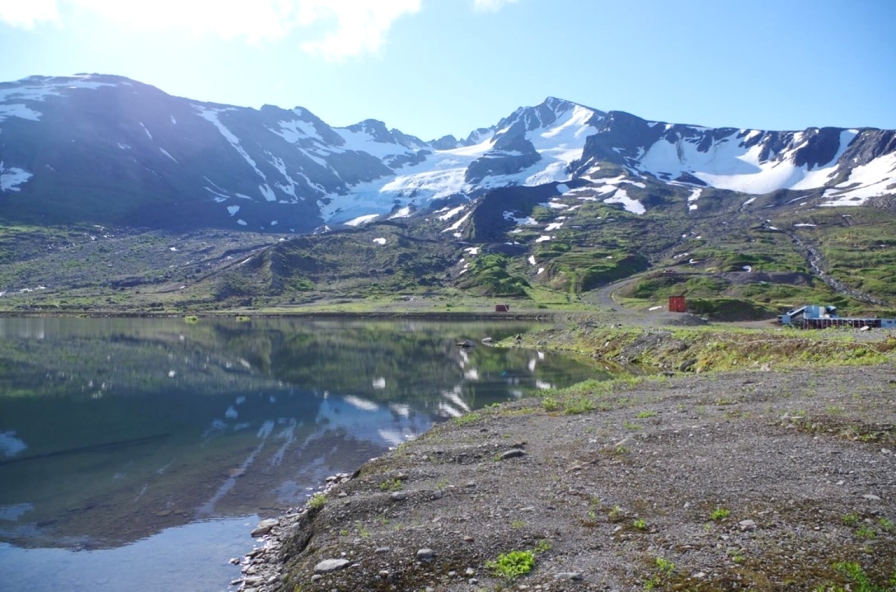TICKERS: AEM, AGC, AU; ANG; AGG; AGD, ATM, EOM, GMV, , GUY, , KTN, LPK, , NES, GLDX, , SWD, TXG, SA; SOACF
Dale Mah: Gold Companies to Watch from the Yukon to Colombia
Interview
Source: Brian Sylvester of The Gold Report (9/16/11)
 From the Yukon to Colombia, with stops in Nevada and Mexico, Dale Mah, an equity research analyst with Mackie Research, covers the map looking for exciting exploration plays. Mah, a trained geologist with 14 years of experience, shares his calculations and insights into how early-stage exploration plays can be safe and satisfying in this exclusive Gold Report interview.
From the Yukon to Colombia, with stops in Nevada and Mexico, Dale Mah, an equity research analyst with Mackie Research, covers the map looking for exciting exploration plays. Mah, a trained geologist with 14 years of experience, shares his calculations and insights into how early-stage exploration plays can be safe and satisfying in this exclusive Gold Report interview.
Dale Mah: Analysts have their own criteria for what's worthy of coverage and there are many variables for evaluating a project. The major difference between bulk-tonnage, low-grade versus low-tonnage, high-grade projects is that the former are generally cheaper to exploit, easier to build a resource and, in some cases, easier to market.
Atacama Pacific has a 3.6 million ounce (Moz.) resource. In our model, a 44,000-tons-per-day (tpd) operation could produce more than 200,000 oz. of gold for 14 years. Those numbers make it easier to finance or to find a partner, because you know it has long-term potential.
TGR: Are the large-tonnage bulk operations easier to market on the sell-side?
DM: In my experience, yes. A project with 5-10 Moz. and a 10-to-20-year mine life is a long-term investment. You know what is going to happen in the next 10 to 20 years. You can build your mine plan from a textbook, whereas underground, you have to follow the structure and work off a mine plan that needs to be updated on a regular basis and hope it doesn’t disappear or get faulted off.
TGR: High-grade underground veins are rare. There are many more average-grade veins—say in the 4–6 grams per ton (g/t) range. Are those projects being developed less often, given the lack of financing?
DM: The terminology of high-grade and low-grade is all relative. What used to be high-grade can be considered very high-grade nowadays, conversely, what used to be low-grade can now be high-grade. For example, 1 g/t is low-grade for a decent open pit. Underground, anything high-grade is 4–5 g/t. Double digits, like 9–10 g/t overall, is very high-grade.
As far as operating costs go, you can't beat an open-pit mine for processing thousands of tons per day. We are seeing a shift toward feasibility projects looking at bulk tonnage underground situations. You have a tonnage that doesn't quite support a massive open pit or the grades aren't high enough to support conventional underground mining. So, a lot are considering alternative underground methods such as block caving or sublevel caving to mine bulk tonnage underground.
TGR: Agnico-Eagle Mines Ltd. (AEM:TSX; AEM:NYSE) specializes in that.
DM: Yes.
TGR: For geologists in your line of work, drill intercepts are like movie trailers: if they are interesting enough, they make you want to see the bigger picture. When you get a drill intercept release, what do you do?
DM: First, I look at the available public information: the company's website, PowerPoint presentations and technical reports. I look at previous news releases to see if there is a track record or if it's a one-shot wonder. I look at the stock chart to see if there is anything unusual happening. I look to see if good people are involved, a good technical team and strong backers. I look closely at the plan maps and at the intercepts to see the size potential.
TGR: Once you determine size, do you try to calculate a rough net present value?
DM: Not right away. If there has been enough drilling, I'll do a back-of the-envelope estimate to see if it's cut off or if there is room for expansion and growth.
TGR: What are three drill intercepts published in 2011 that got your attention?
DM: On May 17, ICN Resources Ltd. (ICN:TSX.V) hit a 2.9 meter (m) intercept of 1,454 g/t gold on their Goldfield Bonanza Project in western Nevada and they are earning into 80% of the project. That intercept hit over 1 kg. of gold over 3m. This is also within a broader low-grade envelope of 45.6m at grades of 96.3 grams. On August 15, the company followed up with 14.9m of 164.5 grams and 12m of 222.6 grams. Both of those intercepts contained extremely high-grade assays of 900-1,700 g/t gold.
Another is Newstrike Capital Inc. (NES:TSX.V), which announced 230.95m of 7.5 g/t gold from its Ana Paula Project in Mexico on April 20. Newstrike acquired 100% of this project from Goldcorp Inc. (G:TSX; GG:NYSE) in 2010. The mineralization style is typical of nearby deposits in the Guerrero Gold Belt, which includes Torex Gold Resources Inc.'s (TXG:TSX) Morelos Project and Goldcorp's Los Filos Project.
TGR: Why would Goldcorp give up a property like that?
DM: Goldcorp drilled it and knew it had gold, but they were focused on Los Filos. Ana Paula sat in the background as a side project. A lot of people at Newstrike came from Teck who historically explored the area, so they decided to pick up Ana Paula.
TGR: And the third name?
DM: Southern Arc Minerals Inc. (SA:TSX.V), which I cover, announced a 39.7m intercept, grading 9.4 g/t gold from the West Lombok Project in Indonesia on May 25. It's the best hole the company has drilled to date.
TGR: Do ICN, Newstrike and Southern Arc all have bulk tonnage potential or are they underground operations?
DM: Newstrike would be a bulk tonnage at surface scenario. Southern Arc has structures that are probably more typical of underground operations, unless it finds a nice surface envelope with decent grade on it. Then it could start with a small open pit.
ICN has been hitting some extremely high grades, but has also shown potential for a broad, low-grade envelope with internal high-grades. It could be a combination and start with a small, open-pit mine and go underground once the strip ratio gets out of hand.
TGR: You recently returned from Colombia, where you visited Sunward Resources Ltd.'s (SWD:TSX.V) Titiribi copper-gold project, where one hole hit 458m of .46 g/t gold and .11% copper. Tell us about your firsthand reactions.
DM: The main Cerro Vetas zone, where Titiribi is located, had an inferred resource of 3.7 Moz. gold and almost 1 billion pounds of copper, with overall grades comparable to other worldwide porphyry deposits (0.5 g/t gold and .2% copper). It contains porphyry and epithermal targets at or near the surface. It has good alteration and geophysical signature, which are helpful in exploration. I like the cluster of targets that all occur within 5 km. of the main Cerro Vetas zone; several are untested and could increase the resource significantly. I could see growth to the 5-6 Moz. range after incorporating some of the new discoveries and on September 8, 2011, the company announced an 8.28 Moz. gold resource (2.20 Moz. indicated, 6.08 Moz. inferred) that exceeded my expectations by about 35%.
TGR: If the copper there did get developed, would it be a combination underground and open-pit operation?
DM: All things being equal, it would be a perfect example of an open-pit mine. But Colombia's booming mineral exploration industry is having some growing pains now. AngloGold Ashanti Ltd.'s (AU:NYSE; ANG:JSE; AGG:ASX; AGD:LSE) La Colosa and Eco Oro Minerals Corp.'s (EOM:TSX.V) (formerly Greystar Resources Ltd.) projects are having to reevaluate their feasibility studies.
TGR: But Greystar is near the top of a mountain.
DM: Greystar is at elevation, but the underlying issue is about wetlands preservation that is considered crucial to water supply. Basically, a lot of people live downstream from that project and use that water. They don't want a big open-pit mine using a lot of water and cyanide. Greystar had to convert a 9 Moz., open-pit mine to a high-grade underground project that will be just over 2 Moz. It will have a much smaller footprint, use much less water and have less significant environmental impact.
TGR: What is the situation with Sunward's project?
DM: It's very close to the town of Titiribi. Standing on the ridge, you can see Titiribi on one side and the other side is developed for farming and ranching. The region is equatorial, so it gets a lot of rainfall. There is good infrastructure; you can drive to it. It's well below the limits of the no-go zone established by the Colombian government.
TGR: Is there political support for a mine there?
DM: Yes. It's in the Department of Antioquia, which is a pro-mining district. The town of Titiribi is pro-mining and it has good community relations. But, Colombia has no track record of putting large scale mines into production the way Peru and Chile have done.
TGR: Let's look at some other early-stage projects in the Americas that are on your radar and might also have a bulk tonnage appeal.
DM: We have been watching GMV Minerals Inc. (GMV:TSX.V) in Guyana. The company has been plagued by technical drill issues, but is on track to complete its 10,000m drill program this year, drilling in areas with known gold occurrences. It is following the Sandspring Resources Ltd. (SSP:TSX.V) and Guyana Goldfields Inc. (GUY:TSX) model of exploration. If the results we see from GMV are anything like what we see from Sandspring and Guyana Goldfields, it will potentially be a good bulk tonnage scenario.
TGR: Could GMV get as big as Sandspring, which is about 8 Moz. gold plus copper?
DM: It's too early to tell. We haven't seen any drill results, but the potential is there geologically. They are working a land package that came from the same vendor that provided Sandspring and Guyana Goldfields their properties. GMV's property borders one of Guyana Goldfields' projects.
TGR: You have written that GMV has alluvial gold. What does that mean in terms of its metallurgy and its mineability?
DM: Alluvial gold has come out of bedrock, been moved around by water, and deposited in sand and gravel, or old stream beds. It is easily recoverable. You can process river gravel or river sands over giant shaker tables or sluice boxes and recover gold using gravity methods. You don't have to process rock by using cyanide.
GMV uses local miners as their exploration tool, people who are already finding gold in the area. It is likely to set up a drill very close to some of the pits because the gold has been weathered out of the bedrock source. The company will conduct geochemical and geophysical surveys to test for potential bedrock sources.
TGR: In a recent research report you wrote about Smash Minerals Corp. (SSH:TSX.V), which holds over 4,100 claims and is one of the largest landholders in the Yukon, covering 846 sq. km. Smash planned to drill 3,000m this summer on several targets. Is there bulk tonnage potential in this area of the Yukon?
DM: Again, it's too early to tell. From what I read about Smash's targets, the company is focusing on structural zones. That would imply low to moderate tonnage with moderate to high grades. If Smash succeeds in hitting mineralization, I would look for a zone of approximately 30m, grading 3 g/t before labeling it as having bulk tonnage potential.
TGR: Has there been any news out of Smash Minerals' summer exploration program?
DM: No, we are eagerly awaiting news. The company received assays from more than 11,000 surface soil and channel rock samples. It prioritized at least five zones for drill testing and started drilling about three weeks ago. It will likely continue drilling as late as it can, but will probably be finished by October. I would look for news in November, maybe earlier.
TGR: When did you last travel to the Yukon?
DM: I visited Smash Minerals two months ago. It has geography on its side. The property adjoins the former Underworld project, now owned by Kinross.
Smash has a very good exploration program underway. It is trying to accomplish two or three seasons worth of exploration in two or three months. This year, the company did a massive grid geochemical survey and some tested a few trenches. It collected some rock channel samples and started to drill shortly after that. It is being very aggressive. Now, we will just hope for the best.
TGR: Has Smash assembled a good exploration team?
DM: That's one of the things that impressed me the most. Smash uses a world-renowned geochemist named Dennis Arne. He set up a top notch procedure for sample collection. Everything—from the assay procedure, how many grams will be assayed, to where the sample comes from and where it is collected—has been extremely well designed and executed.
TGR: Are there any other exploration stories you want to share with our readers?
DM: I would mention Lupaka Gold Corp. (LPK:TSX), which started trading in June 2011. Crucero is their flagship, a 1.25 Moz. project in Peru. Those resources are in a target called A-1. There are 10 other targets defined by geology, geochemistry and geophysics that all occur within a 4–5 km. area. The company has an 11,000m drill program underway.
Another is Kootenay Gold Inc. (KTN:TSX.V). Despite the name, their main project is the Promontorio silver-lead-zinc deposit in Mexico. It has an NI 43-101 compliant resource of about 10 Moz. silver, 110 million pounds (Mlb.) of lead and 125 Mlb. of zinc. It also has an extension to the southwest that could double the resource. One of the holes, DH58, was announced earlier this year. It was drilled outside resource and hit a 205m intercept of 49 g/t of silver, .76% lead and 23% zinc.
TGR: Any other thoughts on your coverage sector?
DM: I cover two companies in Brazil. The first is Magellan Minerals Ltd. (MNM:TSX.V) Magellan's main project is Cuiú Cuiú, a 1.3 Moz. resource, located 25 km. northwest of El Dorado Gold Corp.'s (ELD:TSX; EGO:NYSE) 2.5 Moz. Tocantinzinho deposit. Magellan recently discovered a new zone that could represent near-surface resources.
The other is Amarillo Gold Corp. (AGC:TSX.V). It recently announced a resource update where it converted almost all of its inferred resource to the measured and indicated category. It now stands at 1.33 Moz., an increase of 11% overall, with 1.17 Moz. measured and inferred that is 88% of the total. Amarillo Gold also improved the overall grade as well, going from 1.51 g/t to 1.72 g/t. The Mara Rosa Project is in the prefeasibility stage, has good infrastructure and could be built for just over US$110M. In my model, this would be paid back in year 1 of a 12-year mine life. The company has good exploration potential along trend and at the Lavras do Sul Project in southern Brazil.
TGR: Now that we’re nearing the end of Q3, do you think the junior gold sector will outperform gold in the last three months of 2011?
DM: I would like to think so, but I'm not sure of the timeframe. A lot of situations in the world right now are holding things back. If you look at the seasonality of the exploration cycle, the fall is typically the strongest part of the year. A lot of the results that companies have spent the last three or four months collecting should be coming out in Q4. It will take a few good, significant discoveries and some good drill intercepts to get the excitement back. I hope that once that happens, we will start building some momentum.
TGR: Dale, thank you for your time and your insights.
Dale Mah is an Equity Research Analyst based in Mackie Research Capital's Vancouver office. Dale joined Mackie Research Capital in June 2010 after working in mining and mineral exploration industries for over 14 years and has experience in base metals, diamonds and gold in all stages of mineral exploration and mining, including grassroots exploration, advanced projects, production geology, mineral processing and resource estimation. He focuses on junior and developing exploration companies in the mining sector operating worldwide. Dale graduated with a Bachelor of Science with a specialization in geology from the University of Alberta in 1996, and has worked with both junior exploration companies and major mining companies.
Want to read more exclusive Gold Report interviews like this? Sign up for our free e-newsletter, and you'll learn when new articles have been published. To see a list of recent interviews with industry analysts and commentators, visit our Exclusive Interviews page.
DISCLOSURE:
1) Brian Sylvester of The Gold Report conducted this interview. He personally and/or his family own shares of the following companies mentioned in this interview: None.
2) The following companies mentioned in the interview are sponsors of The Gold Report: Smash Minerals Corp., Sandspring Resources Ltd., Guyana Goldfields Inc., GMV Minerals Inc., Sunward Resources Ltd., Newstrike Capital Inc., Goldcorp Inc., Amarillo Gold Corp.
3) Dale Mah: I personally and/or my family own shares of the following companies mentioned in this interview: None. I personally and/or my family am paid by the following companies mentioned in this interview: None.



































